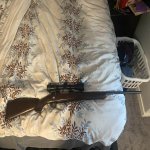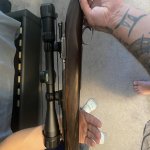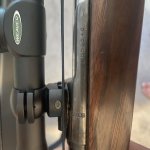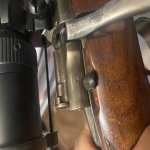You are using an out of date browser. It may not display this or other websites correctly.
You should upgrade or use an alternative browser.
You should upgrade or use an alternative browser.
6.5x55 reloading
- Thread starter Matteralus
- Start date
I beleive it’s a modern action. At one point in its life the scope mounts were brazed on and it covered up the ID markings. Calibre, make , model etc. I beleive it’s an m96… can’t be much older than 80s.
If it’s a M96 it’s a lot older then the 80’s ! RJ
- Location
- Western Manitoba
If it’s a M96 it’s a lot older then the 80’s ! RJ
This for sure! From Crown Jewels book, I think many M94, M96 and the various M38 were being sold off as surplus by Sweden, starting in 1950's?? Although, I see Internet pictures that the Swede Palace guards still carry M94-13, with the bayonets - or, at least the guards that are out and about for public display for tourists.
Well - its a sporterized small ring military action. Commercial actions were typically factory drilled and tapped, so no need for brazing the scope bases. Published load data, such as Hodgdon, is suitable for these older small ring actions. No need to hot rod the 6.5 anyway, it performs very well at modest pressures.
Well - its a sporterized small ring military action. Commercial actions were typically factory drilled and tapped, so no need for brazing the scope bases. Published load data, such as Hodgdon, is suitable for these older small ring actions. No need to hot rod the 6.5 anyway, it performs very well at modest pressures.
Soldering on bases was a European thing, mostly. There were commercial 96's, but they date back to the 20's. It is a good action, made of great Swedish steel. I have had quite a few of them over the years, including one rechambered to 6.5-06, and another in 30-06 from the factory. A third in 9.3x57 and another in 9.3x60. They are a very strong action, considering their age and design features. I have a Win 70 in 6.5x55 too, and the loads in that aren't any faster than the loads in the 96. Your mileage may vary, so work up. - dan
Dan, I have a Husky M38 dated 1946 whose action was a donor for a 6mm Remington project. I don't load it HOT but pressures are definitely well above milsurp 6.5x55.
I've put well over a thousand rounds through it and haven't seen any signs of stretching or cracking while checking it out magnetically.
The action has been modified with a kit that used to be available to #### on opening, rather than on closing.
It's one of my favorite rifles and has taken a lot of Coyotes and Marmots out of ranchers fields.
The sad reality of the 6.5 Swede case is that it just cries to be loaded to better performances. Same goes for the 7x57 and 8x57, 30-06 etc.
That being said, I've had a M38 receiver give a catastrophic failure with a max load of #44 powder (IMR3031), over standard CCI LR primers under 140 spbt bullets.
The top of the receiver blew off and stuck in the wall of the range.
When we checked that receiver, the reason it failed was obvious. When it was assembled, after its last FTR, it was over tightened and cracked.
I would have been able to detect this if I had bothered to magnaflux the receiver ring. Instead, I just trusted the proof tests done after the FTR.
#44 powder was a surplus Bofors made powder offered by Higginsons back in the day and the equivalent of IMR3031 but just 2% slower.
This powder went bad after a few years and my load may have contained powder that had broken down.
When this powder was used, after starting to turn, it usually caused rusting of the bore. That didn't happen when my rifle failed.
Any surplus rifle can give a negative surprise, when it's least expected.
I sold Potashminer a P14 barreled action a few years ago that was never assembled as a rifle. He went to take the barrel off it and the receiver cracked. Now, why this happened??? Was it cracked when I sold it? Not that I could see and I did check for that, before selling it.
Had it been tightened so much that it succumbed to the stress when PM unscrewed the barrel???
A few weeks ago, I had a lovely pristine 1935 Brazilian receiver crack on me when I went to pull the barrel from it, so I could drill and tap the receiver. If someone had told me this would happen on a 1935, made in Oberndorf, I would have been extremely skeptical.
This rifle still had grease in the bore and action, but someone had cut the barrel back and reprofiled the rear receiver bridge for a sporter back when these rifles could be had for $75, which was about a third of what a commercial action cost back then.
It broke my heart to see that lovely action destroyed, but I did manage to save the barrel, which now sits on another 98. Just need to get it to the range to see how it shoots.
I've put well over a thousand rounds through it and haven't seen any signs of stretching or cracking while checking it out magnetically.
The action has been modified with a kit that used to be available to #### on opening, rather than on closing.
It's one of my favorite rifles and has taken a lot of Coyotes and Marmots out of ranchers fields.
The sad reality of the 6.5 Swede case is that it just cries to be loaded to better performances. Same goes for the 7x57 and 8x57, 30-06 etc.
That being said, I've had a M38 receiver give a catastrophic failure with a max load of #44 powder (IMR3031), over standard CCI LR primers under 140 spbt bullets.
The top of the receiver blew off and stuck in the wall of the range.
When we checked that receiver, the reason it failed was obvious. When it was assembled, after its last FTR, it was over tightened and cracked.
I would have been able to detect this if I had bothered to magnaflux the receiver ring. Instead, I just trusted the proof tests done after the FTR.
#44 powder was a surplus Bofors made powder offered by Higginsons back in the day and the equivalent of IMR3031 but just 2% slower.
This powder went bad after a few years and my load may have contained powder that had broken down.
When this powder was used, after starting to turn, it usually caused rusting of the bore. That didn't happen when my rifle failed.
Any surplus rifle can give a negative surprise, when it's least expected.
I sold Potashminer a P14 barreled action a few years ago that was never assembled as a rifle. He went to take the barrel off it and the receiver cracked. Now, why this happened??? Was it cracked when I sold it? Not that I could see and I did check for that, before selling it.
Had it been tightened so much that it succumbed to the stress when PM unscrewed the barrel???
A few weeks ago, I had a lovely pristine 1935 Brazilian receiver crack on me when I went to pull the barrel from it, so I could drill and tap the receiver. If someone had told me this would happen on a 1935, made in Oberndorf, I would have been extremely skeptical.
This rifle still had grease in the bore and action, but someone had cut the barrel back and reprofiled the rear receiver bridge for a sporter back when these rifles could be had for $75, which was about a third of what a commercial action cost back then.
It broke my heart to see that lovely action destroyed, but I did manage to save the barrel, which now sits on another 98. Just need to get it to the range to see how it shoots.
- Location
- Western Manitoba
...
I sold Potashminer a P14 barreled action a few years ago that was never assembled as a rifle. He went to take the barrel off it and the receiver cracked. Now, why this happened??? Was it cracked when I sold it? Not that I could see and I did check for that, before selling it.
Had it been tightened so much that it succumbed to the stress when PM unscrewed the barrel???
...
I would give some very minor corrections to that story in "bold" - it was a WWII USA made "High Standard" (HS) barrel - so was chambered in 30-06, not 303 British - in a WWI M1917 "E" receiver. I wanted the barrel for a rebuild to go on a WWII rebuild stock, etc. I discovered the crack when I cleaned off the outer grease the barrelled action was in. So was not the original barrel - and I have no clue when that receiver cracked - when original barrel was unscrewed (?), when replacement screwed on (?), or just sitting under that grease (?). I doubt either of first two instances, or bearhunter would have noticed, I am sure. That barrel unscrewed from that cracked receiver, and screwed into another "E" M1917 receiver, and head spaced appropriately, without drama.
I shared pictures with bearhunter - I had read about P14 / P17 receivers "cracking", but was first I had ever actually seen for myself - I thought that he would be interested to see those images.
As per other comments about "HARD" steel - no kidding!! - my Dad ground off most all ID features what his M1917 was made by - is either "E" or "R" from the serial number - I can not identify beyond that - but I went through several cobalt drill bits - after spot annealing - attempting to get two threaded holes for a receiver sight through that receiver, from right side ahead of the bolt. The four holes for a Weaver side mount - into left wall of that receiver - went very easy.
Last edited:
All true, but I have also had a 700 action fail catastrophically on me as well. Surplus actions are certainly more likely for those types of failures. On the other hand, I have lost count of the surplus rifles I have bought as or made in to sporters in cartridges from 6mm to 475 Ackley. None of those blew up on me. Magnafluxing a receiver on a build for one of these would be a good idea though, if you have access (we had one at work). I have seen cracked P14/M17 receivers, though I haven't personally cracked any. I recall 96 actioned rifles in 308 being used for International competition in the early 60's, though I am not sure what they did to those rifles. I know they shot very, very well (I had one for a while). BH, I had a box of the #44 powder, used it all up some years back. Was a heck of a deal at the time. I also bought 64 pounds from G.I Brass back in the day (similar burning rates), had it delivered to MT and brought it home from there. I still say the 96's are good actions, for the price. Had one I put into a mannlicher stock, #### on closing and a Timney safety and trigger. Chambered for 6x55 AI. That was a fun little rifle. - dan
- Location
- Western Manitoba
To get back to OP question - is multiple ways to have a "Husqvarna" 6.5x55 - so a commercial version - Model 646? or a converted Husqvarna M38? or a converted by Husqvarna M96-38? Should not really matter - Sweden, CIP and SAAMI have been setting standards for 6.5x55 for more than 100 years. Pick whatever - your rifle will be fine - load up 140 grain Spitzer or 160 grain Round Nose and go slay your game - Swedes and Norwegians have been doing so, on our moose size animals, for 100 years or more - because rifles were cheap, and the bullets worked, and they could place the bullets where it mattered. Nothing much has changed. I have examples here bought on CGN - so, "sporters", from 27" down to 20" barrels. Not likely you will turn your Swede into a 264 Win Mag - do not try - is perfectly okay as a 6.5x55.
I happen to use Norma "Golden Target" bullets in my 6.5 x 55's - most often in a CG63 with 12X Leupold - is a "naked" bullet, not moly coated - but I understand that similar is or was used by Swede shooting clubs for target shooting. Might want to read up on what they do - is most definitely not "bench rest" shooting, and "hand-loading" is virtually unheard of in their games - is all factory Norma, I think!!!
I happen to use Norma "Golden Target" bullets in my 6.5 x 55's - most often in a CG63 with 12X Leupold - is a "naked" bullet, not moly coated - but I understand that similar is or was used by Swede shooting clubs for target shooting. Might want to read up on what they do - is most definitely not "bench rest" shooting, and "hand-loading" is virtually unheard of in their games - is all factory Norma, I think!!!
Last edited:
- Location
- SE corner Sk
Thank you so for all the information, if I can figure out how to attach pictures to these posts I would attach some!
Any pointers? Drop box maybe?
If you want send them to my email and I could post them for you?
If you want send them to my email and I could post them for you?
Ya sure what’s your email?
- Location
- SE corner Sk
Ya sure what’s your email?
I'll send you a PM.
- Location
- Western Manitoba
Attachments
Pictures of his rifle from OP - I need some help - is no inspector initials before the serial number - but has thumb cut out - not certain what this one was???
View attachment 606264
View attachment 606265
View attachment 606266
View attachment 606267
Looks like a Swede, sporter stock, aftermarket trigger with side safety. - dan
Looks like a Swede, sporter stock, aftermarket trigger with side safety. - dan
A really nice custom job on a Swede; Husky (crowns and marked on receiver) Stepped military barrel. The bolt is nicely done as is the stock and the safety.
42gr of IMR4350/156-160gr bullet will shoot real nice out of those Swedes with the 1-7.25" twist. Same charge of N-204 works. I killed a lot of moose,bear and deer with those loads always an exit wound and you can eat right up to the bullet hole.
- Location
- Western Manitoba
Pictures of his rifle from OP - I need some help - is no inspector initials before the serial number - but has thumb cut out - not certain what this one was???
View attachment 606266
I may have found explanation in the Crown Jewels book. Table on p. 148 says that serial number was made by Husqvarna as an M38 in 1942. The serial number appears to be in earlier part of that year's production - so Inspector was Gustaf Bjorkenstam - "G.B." - until September 1942, after that was Sten Stenmo - "S.S." - he was Inspector October 1942 until March 1946. So Inspector's initials should precede that serial number - likely was "G.B.", but could have been "S.S.". Zooming in on that picture, might have been some grinding in that area before the re-blue? The letters might have been removed??
From pictures in that Crown Jewels book, would have been three lines of text stamped on top of that front receiver ring - which would mostly be hidden by the front scope base now - top line would have read "HUSQVARNA VAPENFABRIKS" - middle line would have been "Aktiebolag" - and last line would have been "1942", if my guess about date of manufacture is correct.
CORRECTION - maybe? - I have a Husqvarna M38 action that I was intending to "re-build" - but top of receiver rings have been drilled and tapped for scope bases. Serial number is 678### and the date stamped on front receiver ring is 1943. However, there is no Inspector initials to the left of that serial number on receiver wall. Should have been "S.S." - which I found on the rear sight base. So if that rear sight base was to be removed, there would be no Inspector initial stamp on the rifle.
Last edited:
My hunting buddy, Bert, uses nothing but his "little" Rem 600 in 358 Winchester for everything up here very efficiently. He bought a Husqvarna 94 in 6.5X55 for his wife to hunt with more than 40 years ago. Someone had sporterized the stock, shortened the barrel to 22 inches, and had it drilled and tapped for scope bases. We put an old Weaver K4 on it in Weaver rings.
We sighted it in a week before heading out on a hunt. The load was a 140 gr Partition ahead of a case full of the old H4831, and IIRC it shot into a bit under three inches at 200 yards. His wife killed a huge moose with a single shot on the second day of the hunt.
She eventually gave the rifle to one of their grandsons, and he is still using the same load with current H4831.
Ted
We sighted it in a week before heading out on a hunt. The load was a 140 gr Partition ahead of a case full of the old H4831, and IIRC it shot into a bit under three inches at 200 yards. His wife killed a huge moose with a single shot on the second day of the hunt.
She eventually gave the rifle to one of their grandsons, and he is still using the same load with current H4831.
Ted















































































